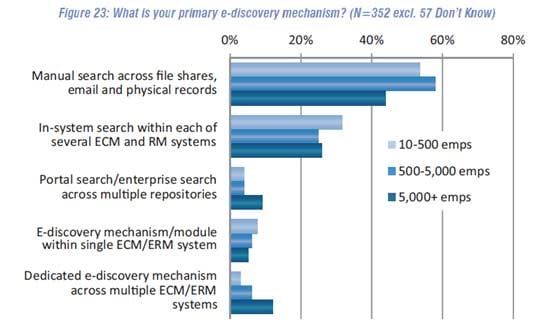
Everyone would love to see less busywork and lower costs. Nowhere is this truer than in legal.
Depending upon the nature of your business and the scope of information you manage, legal eDiscovery costs can account for up to 90 percent of total litigation costs. This is particularly significant for larger, global organizations, as almost half (48 percent) report more than 20 lawsuits filed against them in the previous 12 months.
How can they meet their document demands while protecting their bottom line? Through optimized information processes. When your electronically stored information (ESI) is better organized and accessible from myriad touchpoints, your legal staff can more efficiently identify relevant pieces of information.
Optimize early in the process
In any eDiscovery or disclosure motion, the ability to search digital data is a tremendous convenience. But search is not a solution in and of itself. The vast majority of organizations are still relying on some manual components as part of eDiscovery search processes.

Source: Miles, Doug, “AIIM Industry Watch: Information Governance—Records, Risks and Retention in the Litigation Age,” AIIM, 2013. Online survey of 548 AIIM members from around the world: 76% NA (60% US), 15% Europe.
The process of eDiscovery requires multiple stages of data collection and review. At the outset, the data has to be identified, collected and prepared for search/review, a process that may include scanning documents. In some cases it may be required to place files on legal hold. It is critical at this early stage to have a comprehensive and clear picture of where potentially relevant ESI of different types should be stored. This is the first step in making eDiscovery data work for you.
Silos: necessary or not?
Deciding where and how information needs to be stored is not always straightforward, however. Information silos for sales, customer service, marketing, finance and other departments may require different search tools and criteria. In turn, this may make it more difficult to do the predictive coding required for legal review and setting up “load ready” files. For advanced intricacies like these, outside litigation support resources can help you make use of more advanced search techniques, like clustering, proximity criteria and semantic analytics.
If independent silos are not necessary, it’s a good idea to break them down. Optimized information processes can help accomplish this, and can store your data in formats more compatible for everyone. Fewer databases and less complexity of formats means more efficient identification, collection and verification of data for legal review.
Trim the fat
Yet another straightforward way that optimized information processes can help reduce your eDiscovery exposure is by planning for appropriate data “destruction.” The less data you keep, the less you must review for eDiscovery. So only keep what you have to.
The historical default used to be store whatever you can. But escalating eDiscovery and litigation costs are making that an untenable strategy. Business information of all types and formats is expanding exponentially, including not only email but data from social media channels, customer service chats, SMS texting, instant messaging and more.
Retaining all of it is expensive, burdensome and often unnecessary. Optimized information processes should include comprehensive and consistent “end of life” planning for your ESI.
Optimize growth
To respond to eDiscovery or court-mandated disclosure requirements, your best legal team may have to wade through terabytes of data. Does that sound like a sound strategy for growth? Growing businesses need to execute sales agreements quickly, sign new partners and form strategic alliances to expand profitable channels. There is also an increasing need to explore, negotiate and implement mergers and acquisitions. The kind of agility and business reflexes necessary for competitive growth requires a workforce with unfettered access to the information they need.
Final Thoughts
Optimizing your information processes with an eye on destroying unneeded data, reducing silos and conforming formats of stored data can help you control increasing eDiscovery costs. Just as significantly,better preparation of ESI for review can free your legal resources to devote more time to revenue-generating initiatives and growing your business.
Tags: Blog

